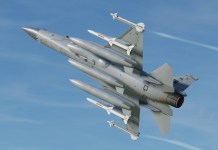Bracing itself for an aerial attack by the Indian Air Force (IAF) on its airbases, China has reportedly begun planning military drills in its Himalayan city of Lhasa, which also serves as the administrative capital of the Tibet Autonomous Region (TAR).
Why Is China Threatening To Shoot-Down ‘Civilian Airlines’ Operating Over The South China Sea?
Tensions have been escalating between the militaries of New Delhi and Beijing, ever since June’s Galwan Valley clash and despite the top diplomats of the two nations reaching a five-point consensus, the situation in the valley has still remained brittle, with both nations preparing themselves for a potential conflict.
India’s Chandrayaan-3 Racing To Catch With China’s Chang’e-5 Lunar Probe

With reports of the IAF deploying Su-30s, MKI, Jaguar and Mirage 2000 fighters in the Ladakh region, soon to be joined by the newly inducted French Rafales, China has stepped up its efforts to prepare itself for an aerial attack and according to a Chinese state-run outlet, Beijing will hold an air raid drill in the Lhasa city on Saturday (September 19).
According to the People’s Daily, the air drill will be held “in order to improve the general public’s national defense concept and civil air defense awareness.”
As reported, the Chinese government states that the sirens of the drill which will be played on Saturday will be of three different types with a total duration of 3 minutes each.
Why China Again Wants To Seize ‘Despang Plains’ Just Like The 1962 India-China War?
The first siren will be played from 12 to 12.03 pm, sounding for 36 seconds with a gap of 24 seconds, which will be followed by the second siren from 12.06 to 12.09 pm, sounding for six seconds with a gap of six seconds, which will be concluded by the last siren which will be a continuous alarm from 12:12 to 12:15 pm.
The People’s Daily, while reiterating that the drill will not interrupt normal life and daily activities, called on “all citizens, government agencies, enterprises, institutions and social organization personnel” to pay attention to the alarms.
WATCH: US Secretive Spaceplane That Was Dubbed To ‘Spy On China’s 1st Space Station’
While no specific information has been publicly stated about the alarms by the Chinese administration, it is reported that the first siren is a pre-raid siren, to turn off lights, with the second siren signaling people to move to air raid shelters, with the final siren indicating the culmination of the raid, after which people are indicated to return to their routine work safely.
In recent times, China has been upgrading the infrastructure of its Lhasa Gonggar Airport, which serves as a base of the PLA Air Force (PLAAF), and is now looking to protect it from an aerial incursion by New Delhi.
After Japan, Turkish Aerospace Giant Displays Its Flying Car: WATCH NOW
Located close to Bhutan’s Doklam region, there has been a construction of hardened shelters in the base in order for China to be able to deploy more fighter jets than before, with the new aircraft shelters also protecting its fighters from enemy missiles and bombs.
China has been wary of the threat that the newly modified air fleet of the IAF can pose with the 4.5 generation French Rafales already boasting an incredible track record for their successful deployment in Afghanistan, Libya, Mali, Central African Republic, Iraq and Syria.
The drill in Lhasa is not the first one, with the People’s Liberation Army (PLA) reportedly holding a series of drills in the city back in June, and now the PLA is holding several air raid drills across major Chinese cities including Beijing and Shanghai to mark the annual National Defense Education Day.
A retired Indian Army official, Colonel Vinayak Bhat, while writing a column for an Indian publication, India Today, however, feels that the timing of the drills raises several eyebrows with the last Chinese drills to mark the occasion in Lhasa being held back in 2009.
China Says PLA Drills Not Warning, But Rehearsal For Taiwan Takeover
“In the current situation of ongoing border friction between China and India, this looks like Beijing’s psychological warfare tactic to create a climate of fear among local Tibetans,” said Bhat.
As reported earlier, China has been warming up their fifth-generation J-20 stealth fighters, who during recent simulation drills knocked down 17 enemy fighter aircraft, believed to be Indian Su-30s and Rafales, while avoiding all return fire.




